Honda FG110 Mini Tiller Review
- February 19, 2024
- 0 comment
The Honda FG110 is engineered to cater to the diverse needs of gardeners, from hobbyists with small backyard plots to professionals managing larger landscapes. Its design prioritizes user comfort and operational efficiency, making it an invaluable tool for a wide array of gardening projects. Whether you’re breaking new ground, preparing seedbeds, or controlling weeds, the FG110 is equipped to handle the task with precision and ease.
Specifications
- Tiller:TypeMini
- Tilling Width9″
- Tine Diameter8″
- Engine:Honda GX25
- Displacement25cc
- Air filtersemi-dry
- Fuel capacity0.60 qt.
- Transmission Speeds1 – forward
- Tine speed @max engine speed294 rpm
Unboxing and First Impressions
Unboxing the Honda FG110 Mini Tiller immediately showcases Honda’s attention to detail and customer needs. The tiller itself is prominently displayed, securely packed to avoid any damage during transit, reflecting the brand’s commitment to quality and durability. Accompanying the tiller, essential accessories and a comprehensive instruction manual are included, each designed to enhance the user experience. These accessories extend the tiller’s versatility, while the detailed literature provides valuable insights into maintenance, operation, and troubleshooting, ensuring users feel confident and well-supported from the outset.
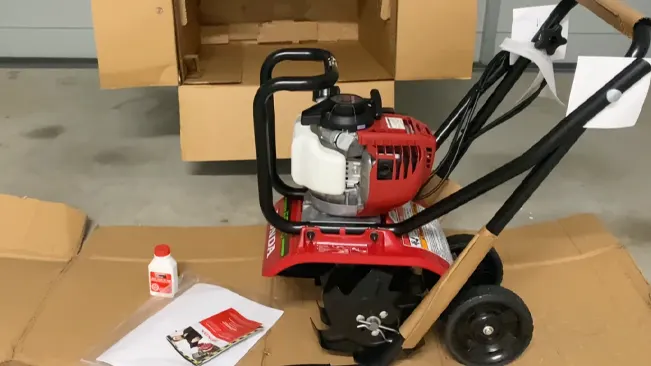
The inclusion of genuine Honda oil is a thoughtful touch that emphasizes the importance of proper maintenance from the very first use. This not only ensures optimal performance but also prolongs the engine’s life, highlighting Honda’s dedication to product longevity and customer satisfaction. The unboxing experience, with its combination of a robustly built tiller, practical accessories, and informative literature, sets a positive tone for the user’s relationship with the product, demonstrating Honda’s commitment to delivering a comprehensive gardening solution.
Setup and Assembly
The assembly of the Honda FG110 Mini Tiller is streamlined to ensure a hassle-free setup, allowing you to get to your gardening tasks quickly. The assembly instructions provided with the tiller are clear and detailed, guiding you step by step through the process. From unfolding the handles to attaching the tines, each step is laid out in an easy-to-follow manner. Illustrations accompany the instructions, offering visual aids to ensure each part is assembled correctly, minimizing the chance of mistakes.
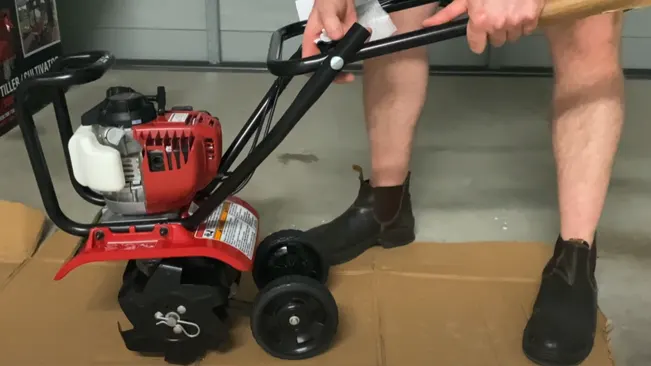
When it comes to tightening the bolts, a few practical tips can make the process smoother. Firstly, it’s essential to ensure that all parts are correctly aligned before attempting to tighten any bolts. Misalignment can not only make tightening more difficult but can also lead to cross-threading, which can damage the threads. When you start to tighten the bolts, do so gradually, alternating between bolts if there are multiple ones in the same area. This ensures even pressure and alignment. The bolts may be stiff initially, requiring a firm hand. Using the correct size wrench or socket will give you better leverage and make the process easier. If the bolts are particularly tough to turn, a drop of lubricant can help ease the process, but be careful not to over-lubricate, as this can attract dirt and debris. Once tightened, these bolts will secure the various components firmly in place, ensuring the tiller’s stability and reliability during use.
Preparing for Use
Before putting the Honda FG110 Mini Tiller to work, it’s crucial to ensure it’s properly prepared, with one of the most important steps being the addition of oil. This step is vital because the engine ships without oil to prevent leaks during transit. Running the engine without oil, even for a short time, can cause severe damage and significantly shorten its lifespan. The oil not only lubricates moving parts to reduce friction but also aids in cooling the engine by carrying heat away from critical components.
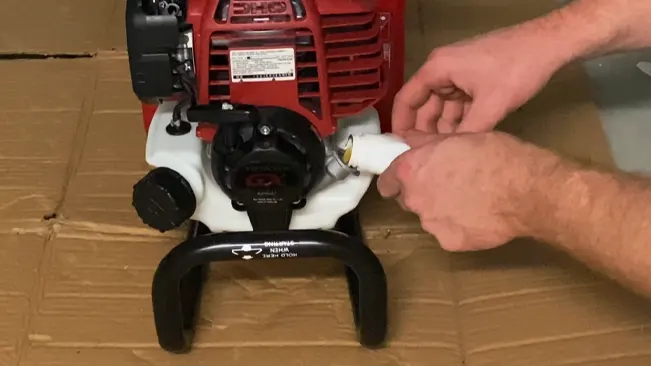
To correctly fill the tiller with oil, start by placing the tiller on a level surface to ensure an accurate reading of the oil level. Locate the oil filler cap, which is typically marked and easily accessible. Before adding oil, check the type and amount recommended by Honda in the instruction manual, as using the correct oil is essential for optimal performance and engine longevity. Pour the oil slowly into the filler neck, taking care not to overfill. The FG110 requires a specific amount of oil, and overfilling can lead to issues such as increased pressure, oil leakage, or even engine damage. After adding oil, wait a few moments to allow it to settle, then check the level using the dipstick attached to the filler cap. Ensure the oil reaches the ‘Full’ mark on the dipstick but does not exceed it. If needed, add more oil gradually until the correct level is achieved. Once filled, replace the filler cap securely, and the tiller is ready for fueling and starting, fully prepared for efficient and safe operation.
Operational Guidance
The Honda FG110 Mini Tiller is engineered for simplicity and ease of use, making it accessible even to those with little experience in operating garden machinery. The process starts with fueling the tiller, emphasizing the use of fresh, high-quality fuel to ensure the engine runs smoothly without any complications. Careful attention is given to filling the fuel tank, marked for convenience, to avoid any overflow or spillage. Following fueling, the engine requires priming, a crucial step facilitated by the FG110’s primer bulb located near the carburetor. Pressing the bulb a few times draws fuel into the carburetor, priming the engine for ignition, an essential step for both initial starts and restarts after periods of inactivity.
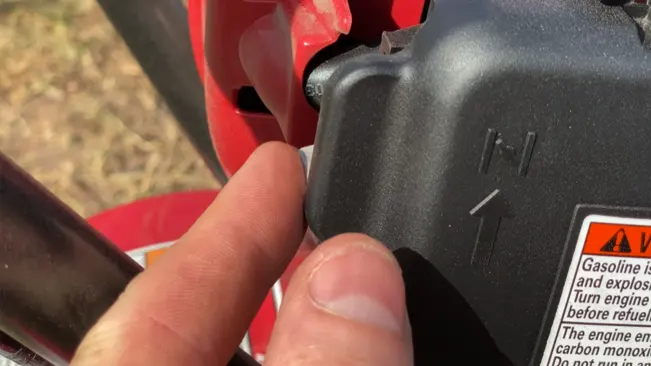
Once the engine is primed, setting the choke to the ‘start’ position is necessary for cold starts, enriching the fuel mixture for optimal engine firing. Pulling the starter rope with a firm and steady motion should then start the engine. If the engine is stubborn, a quick check of the choke setting and primer bulb can often remedy the situation. After the engine springs to life, adjusting the choke to the ‘run’ position allows it to warm up and stabilize for operation. Additionally, the FG110’s design includes transport wheels, enhancing its portability and ease of movement across garden spaces. These wheels, attachable to specific slots on the tiller, facilitate easy relocation without the need for lifting, and can be removed or adjusted when it’s time to till, ensuring the tines effectively engage with the soil. This thoughtful incorporation of transport wheels underscores the FG110’s versatility and convenience for a range of gardening activities.
Honda FG110 Mini Tiller Comparative Analysis Table
| Feature | Honda FG110 Mini Tiller | MANTIS Mini Tiller |
|---|---|---|
| Engine Type | 25cc Honda GX25 Four-Stroke | Varies, often two-stroke or less reputable brands |
| Usability | Lightweight, ergonomic design, easy assembly and start-up | May be similar, but ease of use can vary with assembly complexity and starting reliability |
| Versatility | Adjustable tilling width/depth, optional attachments like aerators and edgers | Similar features available, but ease of attachment and adjustment can vary |
| Durability and Maintenance | High-quality materials, easy maintenance with accessible components | Can vary significantly, with some models requiring more frequent maintenance or being less durable |
| Overall Value | Higher initial cost but offers long-term reliability, low maintenance, and superior performance | Initial costs may be lower, but long-term value can be affected by maintenance costs, durability, and performance |
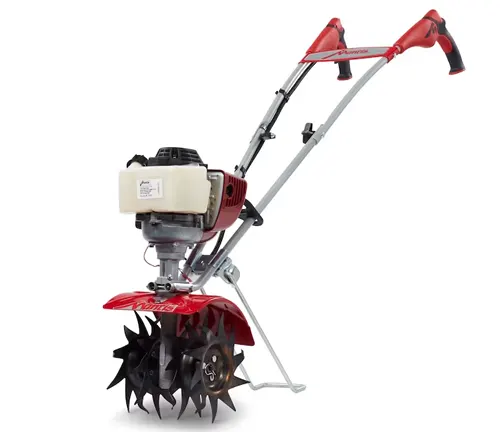
Specifications
- Brand: Mantis
- Type: Mini tiller/cultivator
- Weight: 19-22 lbs (8.6-10 kg) depending on model
- Dimensions: Varies depending on model, but generally around 30″ long, 15″ wide, and 30″ tall
- Handlebars: Adjustable
Summary
The Honda FG110 Mini Tiller excels in engine performance, usability, versatility, and durability when compared to its competitors. Its four-stroke GX25 engine is more reliable and environmentally friendly than the often-used two-stroke engines in other models. The FG110’s design focuses on user comfort and ease of use, with features like ergonomic handles and straightforward assembly and starting procedures that set it apart. Its versatility is enhanced by adjustable tilling capabilities and the availability of optional attachments, making it suitable for a wide range of gardening tasks. In terms of durability and maintenance, the FG110’s quality construction and easy-to-maintain design ensure it remains a reliable tool for years to come. While the initial investment in the FG110 may be higher than some competitors, its overall value, underscored by Honda’s reputation for reliability and performance, makes it a worthwhile choice for serious gardeners looking for a long-term solution.
Pros and Cons of Honda FG110 Mini Tiller
Pros
- Powerful Engine: The Honda GX25 25cc four-stroke engine delivers reliable and efficient power, making it suitable for a variety of soil types and conditions.
- Lightweight and Maneuverable: Its compact design and lightweight build make the FG110 easy to handle and maneuver in tight spaces, ideal for small to medium-sized gardens.
- Versatile: Adjustable tilling width and depth allow for customization based on the task at hand, from aerating soil to weeding between rows.
- Durability: Honda is known for its durable construction and the FG110 is no exception, built to withstand rigorous use over time.
- User-Friendly: Features like an easy-start engine and straightforward assembly process make the FG110 accessible even to those with limited experience with garden tillers.
- Low Maintenance: The serviceable transmission and easy-access points for routine maintenance tasks contribute to the tiller’s overall low maintenance requirements.
- Quiet Operation: The four-stroke engine is notably quieter than two-stroke engines, making for a more pleasant working environment.
Cons
- Price: The FG110 may be priced higher than some other mini tillers on the market, which could be a deterrent for those on a tight budget.
- Limited for Large Areas: While excellent for small to medium gardens, its size and power might not be sufficient for tilling very large or exceptionally tough terrains.
- Weight Distribution: Some users might find the weight distribution to be less balanced compared to larger tillers, which could affect handling during extended use.
- Accessories: While versatile, some of the optional accessories that extend the tiller’s functionality may need to be purchased separately, adding to the overall cost.
- Fuel Requirements: The four-stroke engine requires pure gasoline, without the need for mixing oil, which might be inconvenient for those used to two-stroke engines.
Maintenance
- Regular maintenance, especially greasing the transmission, is crucial for durability.
- Greasing reduces friction among moving parts in the transmission, minimizing wear and tear.
- This is particularly important for a tiller operating in dense and rocky soil conditions.
- Without proper lubrication, transmission components can degrade prematurely, leading to decreased efficiency or failure.
- It’s important to follow the FG110’s user manual for a greasing schedule.
- Typically, this involves applying high-quality, suitable grease to specific points on the transmission.
- These points are usually accessible and clearly marked for easy user application.
- Using the right type of grease, as specified by Honda, ensures optimal protection and performance.
Conclusion
In conclusion, the Honda FG110 Mini Tiller emerges as a standout choice for gardeners seeking a blend of performance, durability, and ease of use in a compact package. Its powerful Honda GX25 engine, coupled with a lightweight and maneuverable design, makes it an ideal tool for small to medium-sized gardens. The tiller’s versatility, underscored by adjustable tilling widths and depths, along with its user-friendly features, ensures it can meet a variety of soil cultivation needs. While the higher price point and limited suitability for very large areas may be seen as drawbacks, the overall reliability, low maintenance, and quiet operation of the FG110 offer significant value. For those prioritizing quality and long-term performance in their gardening equipment, the Honda FG110 Mini Tiller represents a wise investment, capable of enhancing the gardening experience and contributing to the health and beauty of garden spaces.
FAQS
1. Can the Honda FG110 Mini Tiller be used for large gardens?
While the FG110 is ideal for small to medium-sized gardens due to its compact size and maneuverability, it may not be the best choice for very large areas or extremely tough terrains. Its design is optimized for ease of use in tighter spaces and more detailed garden work.
2. How often should the transmission be greased?
It’s recommended to refer to the Honda FG110’s user manual for specific maintenance schedules. Generally, greasing the transmission should be done at least once per season or after every 20 to 25 hours of use, depending on the soil conditions and frequency of use.
3. Is the Honda FG110 suitable for tilling hard, clay soil?
Yes, the FG110 can tackle hard, clay soil, thanks to its powerful engine and durable tines. However, for extremely compacted soils, it may be necessary to moisten the soil beforehand or make multiple passes for the best results.
4. Are there any attachments available for the Honda FG110 Mini Tiller?
Yes, the FG110 supports various attachments that extend its versatility, including aerators, dethatchers, and edgers. These accessories can be purchased separately and easily attached to enhance the tiller’s functionality for specific gardening tasks.
5. How does the FG110’s four-stroke engine benefit the user compared to a two-stroke engine?
The four-stroke engine of the FG110 offers several advantages, including lower emissions, quieter operation, and no need to mix oil with gasoline. This results in a cleaner, more efficient, and user-friendly experience, especially for prolonged use in residential areas.

Joel Cunningham
Forestry AuthorI'm Joel Cunningham, an expert in pruning and weed management with over a decade of experience. My skills are rooted in formal training and extensive practice, focusing on advanced pruning techniques and efficient weed control. I'm known for my quality work, precision, and deep understanding of plant health and soil dynamics. My contributions extend to educational initiatives where I share sustainable practices and advice, establishing myself as a reliable and authoritative figure in the gardening community.

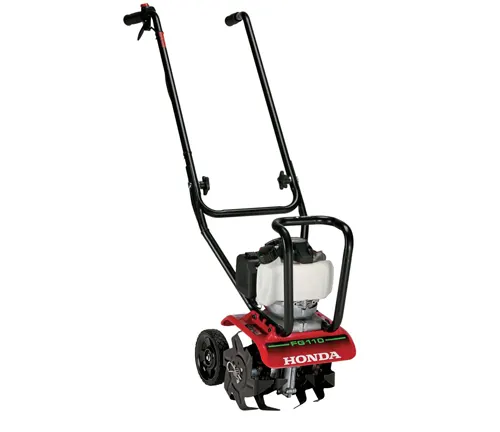
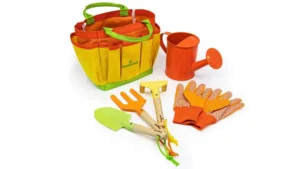
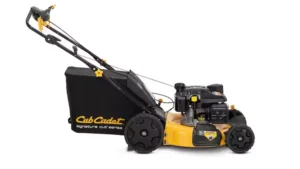

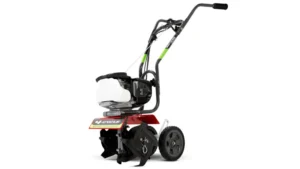
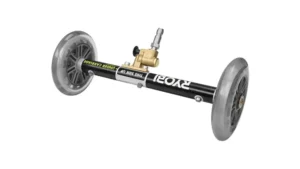

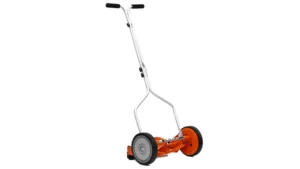

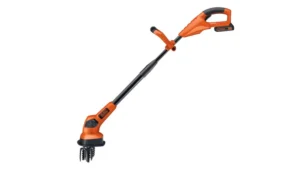

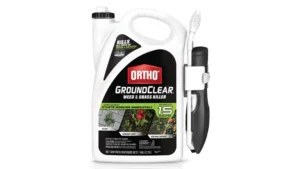

Leave your comment